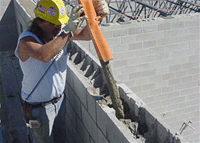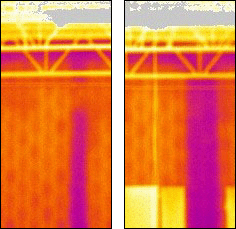From Pompeii to Self-consolidating Grout
Advances in masonry technology
"The ancients by means of writing established the wise and useful practice of handing down to posterity their sentiments on different subjects, so that not only those might not be lost, but that by their works continually increasing, a gradual advancement might be made..."
- Marcus Vitruvius Pollio, "de Architectura"
 Masonry construction is one of the oldest building methods in the world. Several masonry ruins over 5,000 years old still contain their mortar, which is a testament to this building system. Numerous advancements have been developed over the centuries, such as reinforced masonry, which was a monumental advancement, especially in active seismic regions. Today, self-consolidating grout is on the verge of revolutionizing the masonry industry. Looking back over the years, the ingenuity and experience of the Greeks and Romans have made these innovations possible.
Masonry construction is one of the oldest building methods in the world. Several masonry ruins over 5,000 years old still contain their mortar, which is a testament to this building system. Numerous advancements have been developed over the centuries, such as reinforced masonry, which was a monumental advancement, especially in active seismic regions. Today, self-consolidating grout is on the verge of revolutionizing the masonry industry. Looking back over the years, the ingenuity and experience of the Greeks and Romans have made these innovations possible.
Architecture of the Greeks and Romans
Masonry construction using lime mortar became widely used in ancient Greece and Rome (1400 B.C. to A.D. 475). The Romans are credited with a large number of innovations in construction, including hydraulic cement, a mixture of volcanic ash and lime.
Roman architect and engineer Marcus Vitruvius Pollio (c. 27 B.C.) documented construction methods in his series of books titled "de Architectura." In these documents, which have also been referred to as the first construction specification, Vitruvius details aspects of construction from picking a building site to laying out a city, making brick, using lime, and picking sand for mortar. Vitruvius also provides a detailed description of constructing walls:
...In this species the faces are wrought. The stones are, without working, deposited in the cavity between the two faces, and bedded in mortar as the wall is carried up...so that there are thus three distinct thicknesses; namely, the two side or facings, and filling in.
With the exception of steel reinforcement (e.g., rebar), Vitruvius' description sounds similar to the grouting process in reinforced brick masonry of today as described by the Brick Institute of America: "...the brick masonry is the permanent formwork for the grout."1
Had the technology existed, perhaps the citizens of Pompeii could have benefited from using steel reinforcement in the construction of their walls. Pompeii's buildings were constructed in a manner similar to that described by Vitruvius, and are a perfect example of what can happen with non-reinforced masonry in an active seismic region. The fate of Pompeii is well known ? Mount Vesuvius erupted in A.D. 79, burying the city in volcanic ash, encapsulating some of its more unlucky citizens. Archeologists have uncovered evidence that some of the masonry walls were damaged and subsequently repaired in A.D. 62. Evidence suggests a mode of failure associated with seismic loadings due to a severe earthquake that year.2
Masonry of the 20th Century
The cost of materials at the turn of 20th century made the advent of concrete masonry units, which were first molded manually in 1882, an important advancement in masonry technology. In 1900, Harmon S. Palmer earned a patent for developing a commercial process for producing hollow concrete block. In 1904, a hand-tamp block machine was developed, and in 1909, an automated-tamp and power self-discharging machine was introduced.
Another important innovation was the introduction of reinforced masonry. Marc Isambard Brunel is credited with the introduction of reinforced masonry in 1813 when he suggested using steel to reinforce a chimney that was under construction. The practice of reinforcing masonry walls became extremely popular after the 1933 earthquake in Long Beach, Calif.3 According to the National Information Service for Earthquake Engineering at the University of California, Berkley, the Long Beach earthquake ? with an estimated magnitude of 6.25 on the Richter scale ? resulted in catastrophic structural damage to unreinforced masonry structures. However, buildings that were constructed using reinforced masonry technology survived the earthquake with little or no structural damage.
Current Technology
 Infrared imagery of two different grout placements. The placement on the left contains a large void approximately two-thirds up the wall. |
Grout is placed in a series of lifts into cavities between wythes and within cores and cells of both brick and block walls. Grout is essential for the transfer of lateral stresses from the block or brick to the steel reinforcement. The difference between conventional grout and concrete is that it has a high water-to-cementitious ratio and, as a consequence, possesses a slump between eight and 11 inches (20.3 cm to 27.9 cm). The high slump allows for easier consolidation, especially with areas where steel is congested. The high water-to-cementitious ratio compensates for the suction of moisture by the masonry units. Common problems associated with grouting include voids (see images above) caused by using a grout that is too stiff, bridging at cell offsets, or other obstructions.
High-lift grouting was developed in San Francisco in the late 1950s. The Masonry Standards Joint Committee recently approved a code change that increases the maximum lift height from five feet to 12 feet eight inches. This change was based on research conducted at the National Concrete Masonry Association (NCMA). With conventional grout, the lifts still need to be consolidated using external vibration.
Self-consolidating grout is the latest innovation in masonry construction. There is currently no definition in the American Concrete Institute or ASTM literature for either self-consolidating concrete (SCC) or self-consolidating grout (SCG). It is generally accepted that SCG must:
- have a fluidity that allows self-consolidation without external energy;
- remain homogeneous during and after placing; and
- easily flow through the reinforcement.
These properties are achieved through the use of polycarboxylate high-range water-reducing admixture in conjunction with a viscosity modifying admixture. The flowable nature of the mix allows for placement through congested reinforcement or grout spaces that are partially blocked without segregation. SCG would require little or no consolidation even in high-lift grouting.
SCG is not currently addressed in the building code, but, according to the NCMA, SCG will likely have a positive impact on construction speed and economy, as well as the masonry of the future.
References
- Technical Notes 17A, Brick Institute of America, August 1997
- Martini, Kirk, Ancient Reconstruction of the Pompeii Forum, An Investigation of Seismic and Volcanic Structural Response. http://urban.arch.virginia.edu/struct/pompeii/home.html
- Amrhein, James E., Information Guide to Grouting Masonry, Masonry Institute of America, 1999
About the Author
Mark Lukkarila is the Technical Services Manager at SPEC MIX, Inc., Mendota Heights, MN. Lukkarila has a bachelor's degree in Earth Science and is a geologist with extensive experience in petrographic analysis. He has been in the concrete and masonry industry for 16 years and, prior to SPEC MIX, was a consultant and Research Lab Manager for Ash Grove Cement Company. He sits on the ASTM committees C 12 and C 12.09; is a voting member of C 9.43, C 9.46, C 9.65; and is a member of the task groups for C 12.05 and C 1324. He is also secretary to the ACI 221, Aggregates Committee.


















